This article was written exclusively for Investing.com
- Gold and silver bulls disappointed in 2021
- Long-term bull markets
- The case for gold in 2022
- Silver likely to follow and magnify gold’s price action
- The worst sectors during one period often outperform the next
The last time excitement overwhelmed the gold market was in August 2020, when the price of gold rose to $2,063 per ounce. Silver, the more volatile precious metal that many market participants call 'gold’s little brother,' rose to the highest price since 2013 in early 2021, when it probed above the $30-per-ounce level. Since then, gold and silver prices have declined and traded in tight ranges. The price action in the top precious metals has been like watching paint dry.
Gold and silver are supposed to be the ultimate inflation barometers, but they did not reflect the rise in the Consumer Price Index in 2021, when it hit an almost four-decade high. Gold has been trading around a pivot point of $1,800 per ounce over the past months, and silver has sat in a range between just below $21.50 and just above $25 per ounce over the past six months.
While most commodities posted impressive gains in 2021, gold and silver prices declined. Even though gold reached an all-time high in 2020 and silver rose to an eight-year peak in 2021, market participants desire immediate gratification. Gold and silver prices are much closer to this century’s highs than the lows, but they did not perform as well as other commodities in 2021. 2022 could be a different story for precious metals.
Disappointment For Gold And Silver Bulls In 2021
Last year, gold and silver bulls had high hopes that higher highs were on the horizon. However, the price action did not offer many opportunities.

Source: CQG
Silver made a new multi-year high in early February 2021, when the price eclipsed the 2020 peak and rose above the $30-per-ounce level for the first time since 2013. However, the buying ran out of steam, leading to a pattern of lower highs and lower lows throughout last year. COMEX silver futures declined 11.59% in 2021.
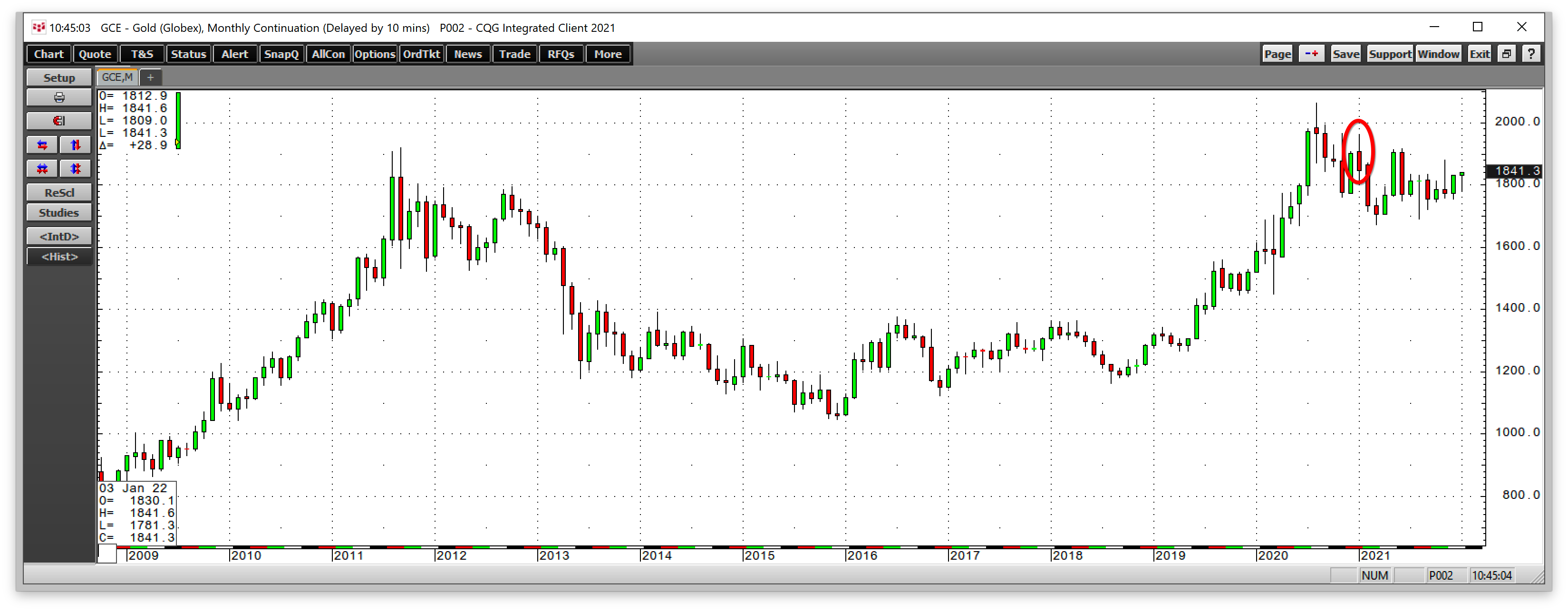
Source: CQG
Gold’s high in 2021 came in early January at $1,962.50 per ounce on the COMEX futures contract. Gold had a disappointing 2021 as it lost 3.51% of its value from the Dec. 31, 2020, close. Gold did not make a higher high or a lower low in 2021 than 2020. Last year was an inside year in the gold futures arena.
Long-Term Bull Markets
While most commodities rose to new multi-year, or in some cases, new all-time highs in 2021, gold and silver did not join the bullish party.
Meanwhile, the long-term bull markets in the leading precious metals remain firmly intact in early 2022.

Source: CQG
The quarterly chart shows that COMEX silver futures reached a low of $4.015 per ounce in 2001. Since then, the precious metal made higher lows and was over 5.7 times higher on Jan. 19, 2021.
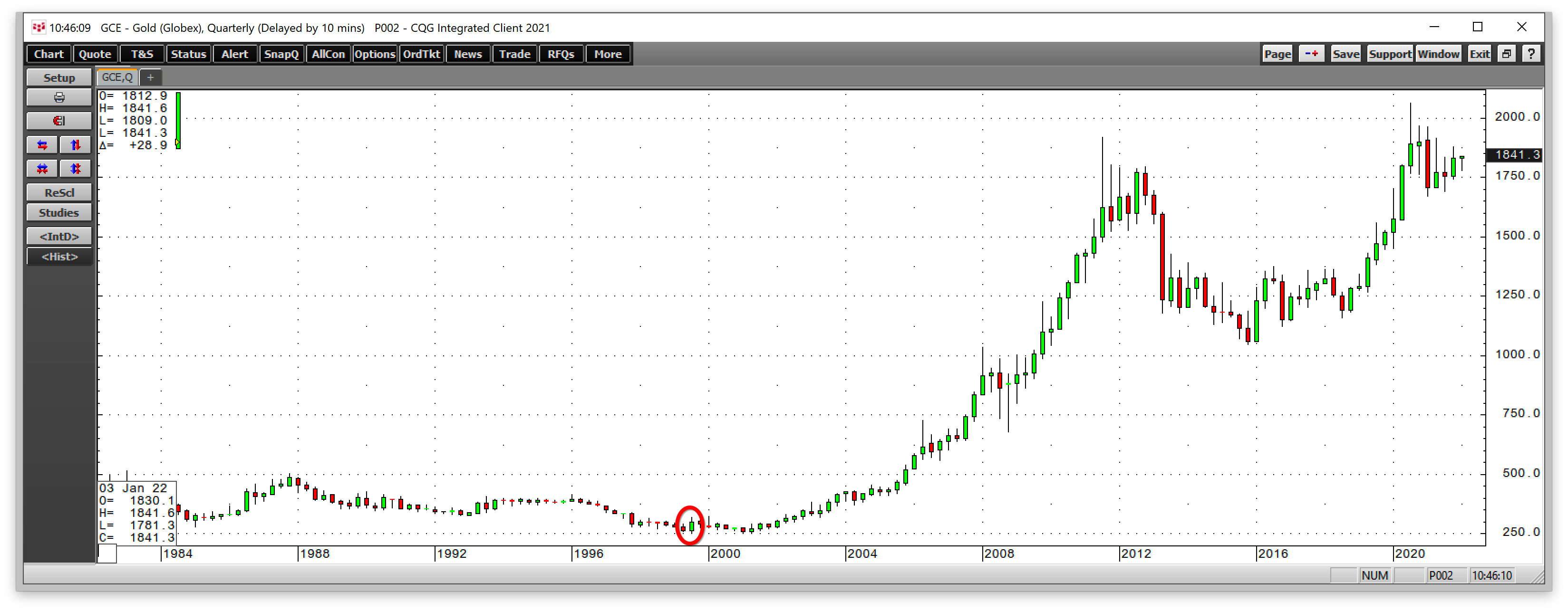
Source: CQG
COMEX gold futures reached a low of $252.50 per ounce in 1999. Gold has made higher lows and higher highs this century, reaching a new record peak in August 2020.
The bearish price action in 2021 did not negate the long-term bullish trends in the gold and silver markets that have been in place for the past two decades.
The Case For Gold In 2022
Four factors support higher gold prices in 2022:
- US inflation consistently rose in 2021. The CPI hit 7%, the highest level in four decades. Excluding food and energy, Core CPI was at 5.5%, well above the Federal Reserve’s 2% average target rate. Producer prices rose by nearly 10% in 2021. Rising inflation is bullish for gold as the metal is an inflation barometer.
- The Fed is far behind the inflationary curve. At the December FOMC meeting, the committee’s forecasts of a 0.90% Fed funds rate in 2022 and 1.60% in 2023 create long-term prospects for negative real interest rates. Negative rates weigh on the dollar’s purchasing power, supporting a higher gold price.
- Central banks and governments continue to be net buyers of gold as it is a means of exchange or a currency. Governments hold gold as a foreign exchange reserve. which validates gold’s role in the global financial system.
- The long-term trend remains higher, and the trend in any market is always your best friend.
After an inside year in 2021, gold has been trading around the $1,800-per-ounce pivot point throughout most of that year. The metal has been digesting its move to a new record high in 2020 and has consolidated around the $1,800 level. Since March 2021, the precious metal has made higher lows.
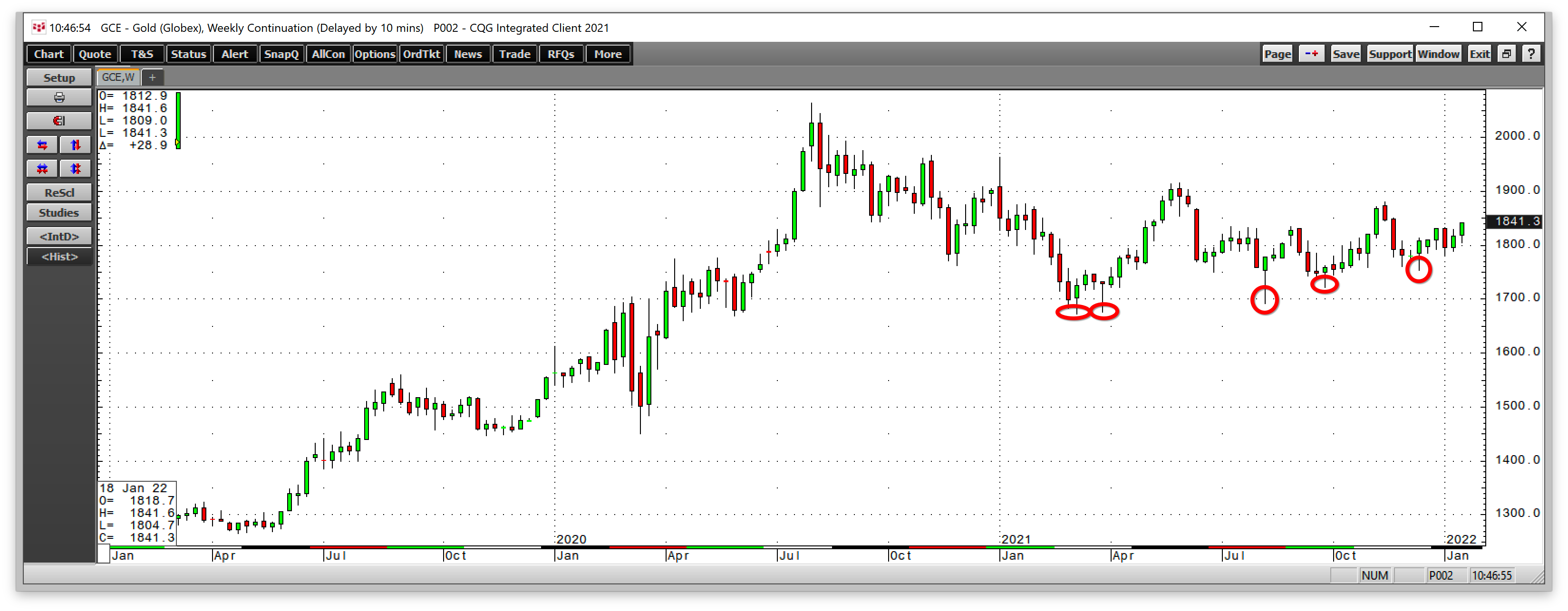
Source: CQG
The chart shows the pattern of higher lows, leading to a wedge pattern of higher lows and lower highs. Wedge formations tend to lead to a breakout to the up or downside. Inflation and other factors favor the upside when gold decides to move.
Silver Likely To Follow And Magnify Gold’s Price Action
Silver’s price tends to magnify gold’s price action. Silver often acts like gold on steroids during bull markets.
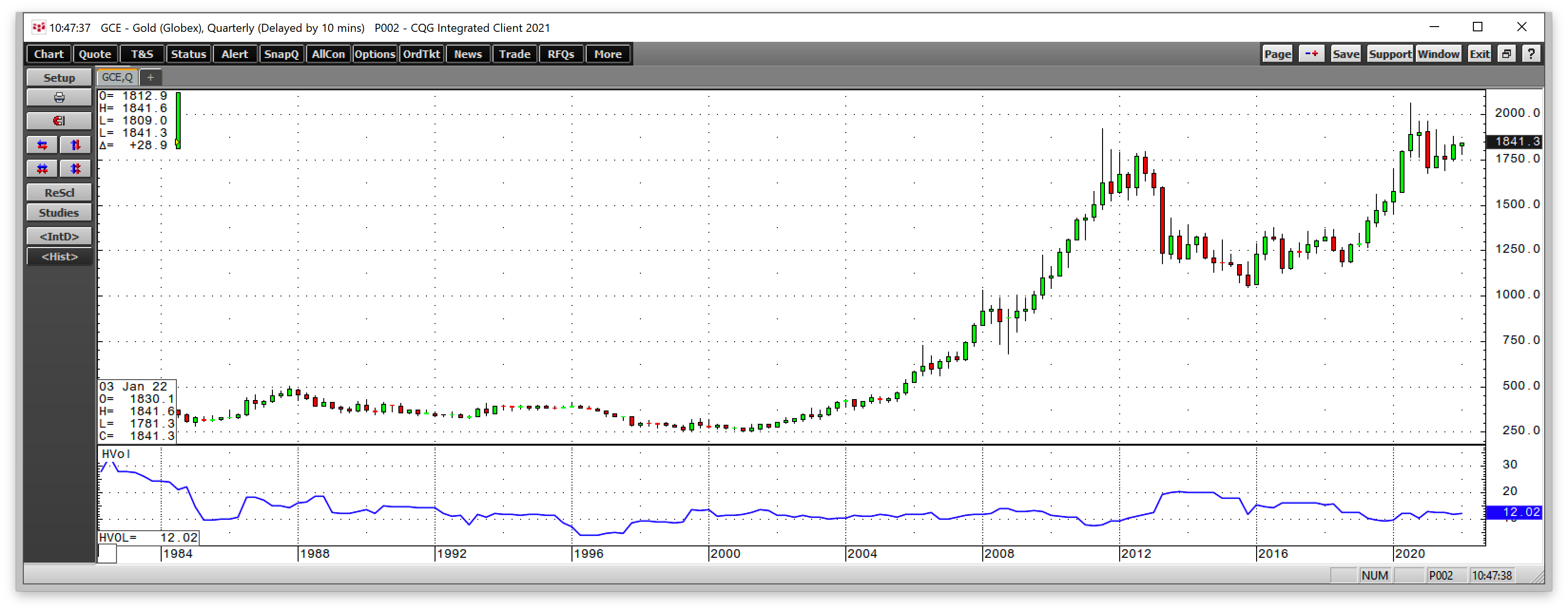
Source: CQG
The chart shows that quarterly historical volatility in the gold futures market ranged from 7.72% to 20.33% since 2000.
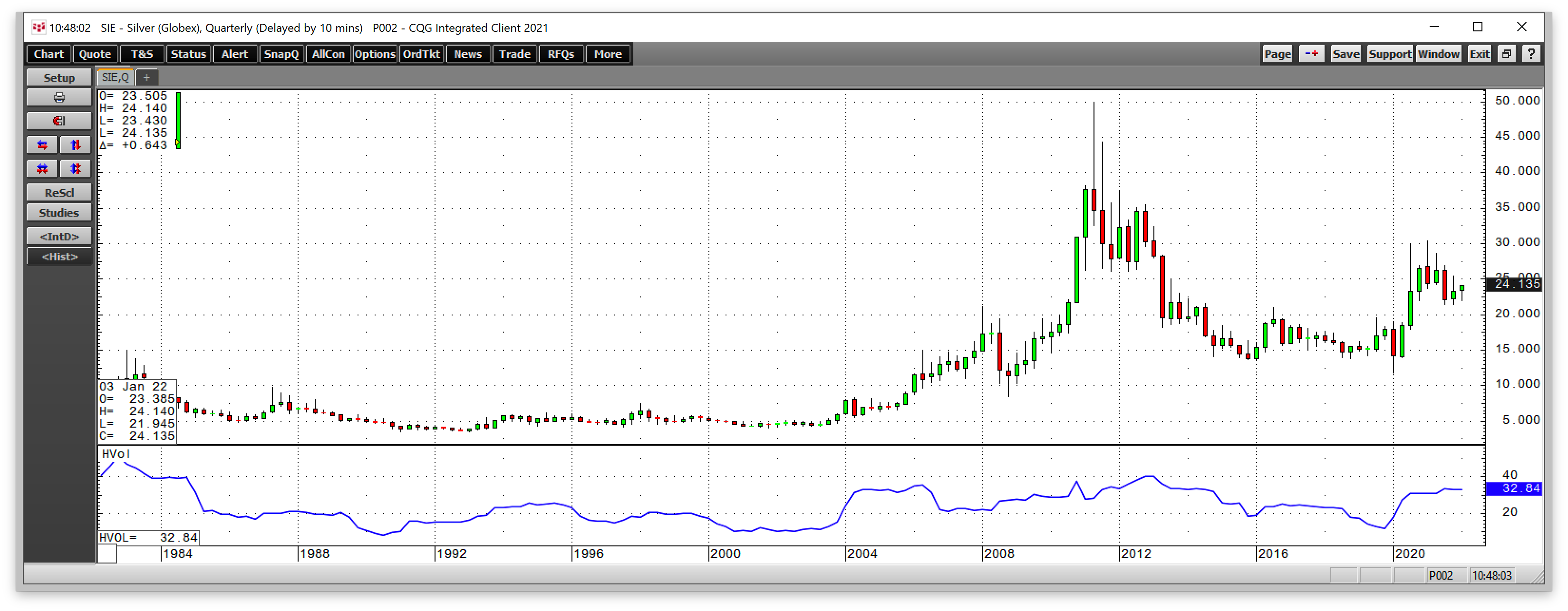
Source: CQG
The price variance metric in the silver futures market has ranged from 9.76% to 40.29% since the turn of this century.
Silver’s lower per-ounce price and penchant for volatility make it a far more speculative metal than gold. When trends develop, speculators tend to pile into the silver market, exacerbating price action on the up or downside.
Worst Sectors During One Period Often Outperform The Next
Precious metals were the worst-performing commodity market sector in 2021. Of 41 of the most liquid commodities that trade on the futures and forward markets in the US and UK in 2021, only eight posted losses for the year. Gold and silver were two of the eight commodities that closed lower on Dec. 31, 2021 than at the end of 2020.
Laggards often become leaders in subsequent periods. Time will tell if gold and silver take the bullish baton in the commodities asset class in 2022.
While the Fed appears ready to address rising inflation, negative real interest rates for as far as the eye can see and the long-term bullish trend are reasons why gold and silver could be ready to break out to the upside and resume the ascent that will take them to higher highs over the coming months.
Gold was trading above the $1,840 level on the COMEX futures contract on Jan. 19, while silver was above $24 per ounce.
